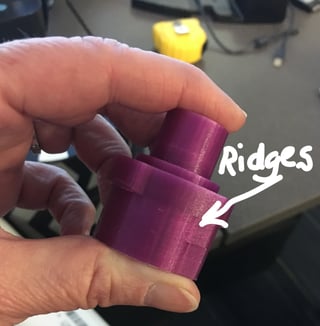At last! It’s time to turn your design into a physical object. While it’s exciting to see something from your imagination turn into reality, there are questions that must be answered before you can begin.
1 | Which prototyping method should you use?
This is a great first question which depends on the answers to the following four. But first, a quick tutorial in prototyping methods.
There are two basic types of manufacturing processes:
Subtractive [in which you remove material to form the part; includes computer numerical control (CNC; a computer guided machine or hand held router cuts away the unwanted material), lathing, machining, milling]
Additive [in which material is added to create the part; often called 3D printing].
It's also important to remember that certain materials lend themselves to specific processes. For example plastic is often used in additive manufacturing; CNC is used for metals; and you typically think of wood being lathed.
2 | What is the purpose of the prototype?
If the purpose of your prototype functional testing, then the method you use is critical. You don’t want to physically test the part in a way that might show a false failure.
Here’s an example. Let’s say your prototype is made using a form of additive manufacturing called fused deposition modeling (FDM). Most people have heard of or seen this process described by the generic, and imprecise, term 3D printing. Simply put, following directions from a computer file, a 3D printer extrudes molten material in multiple layers which cool to create the form. Here's a video if you've never seen this in action:
And here's a photo of a part we printed in our lab using FDM. Look closely, you can see the see the horizontal layers. If you stress the part mechanically — maybe try to bend it — it might crack between layers. But maybe that’s not realistic to how the actual part would break.
might crack between layers. But maybe that’s not realistic to how the actual part would break.
In this case, rather than prototyping using FDM, you might want to use a subtractive 3D method for prototyping, in which you use a solid plastic block of material and remove the material that isn’t in the part. If you bend it and it breaks, it will break based on the design of the part, not on the soundness of the material.
3 | Do these parts need to be air tight?
3D printers are very good unless there is a hiccup in the process. In the absence of material being layered, you will add air. If your part needs to be airtight, you may need a part done by CNC which starts with a solid block of material. It’s simple mathematics. If you’re subtracting and you didn’t take it away, it’s still there.
4 | How many prototypes do you need?
Another thing to consider is the volume of (prototype) parts you need. Some processes are faster than others. If you need just one part, any option is good. Take your pick. But if you want a lot of parts, you’re looking more for a supplier than a process. We work with companies with 3D printers as far as the eye can see. They can load your project on the printer and finish up in a couple days. If you only had access to a single printer it would take two to three weeks.
The size of the part also dictates how quickly you can build it. Most times when you’re ordering a part you don’t have the flexibility to change its size. That’s one thing in favor of CNC. Depending on what you’re looking for, you can break it into smaller parts, glue them together and get a much faster part without having to CNC a very large piece.
5 | Do you have to make your prototype out of the same material that you’re making the part out of?
I have it on good authority that this is not a dumb question. Again, what’s the purpose of the part? For functional testing, you want the material to be close to what you're planning to use for the final product. Maybe you want it to feel soft, you’ll want to prototype in a material that will closely match the feel you're going for. But if you’re trying to confirm your design, say your product is supposed to be hard/rigid, it doesn’t matter if you use something that’s super rigid or semi-rigid. As long as it’s in the ballpark, you’ll get what you’re looking for.
REMEMBER:
- Focus on the problem you’re really trying to solve. Only prototype the part you need to have.
- If you’re concerned about the strength of a part, use a method and material that will give you the best information about that concern.
Prototyping is an exciting step. Doing your research, asking questions and making sure you understand the answers will keep your project moving forward.
Additional reading:
How a Startup Can Minimize Investment Cost and Start Production SoonerHow Small Design Changes Can Affect Product Development Pricing




.jpg?width=176&height=56&name=MR_associatedNetwork_logo%20(1).jpg)